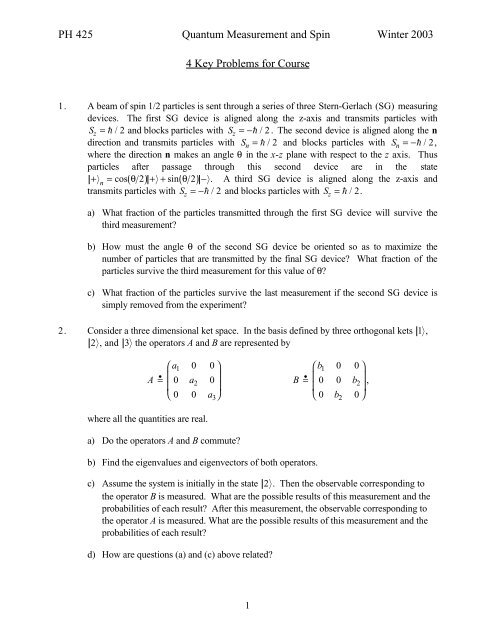Key Problems
Key Problems
Key Problems
Create successful ePaper yourself
Turn your PDF publications into a flip-book with our unique Google optimized e-Paper software.
PH 425 Quantum Measurement and Spin Winter 2003<br />
4 <strong>Key</strong> <strong>Problems</strong> for Course<br />
1. A beam of spin 1/2 particles is sent through a series of three Stern-Gerlach (SG) measuring<br />
devices. The first SG device is aligned along the z-axis and transmits particles with<br />
Sz = h /2 and blocks particles with Sz =−h /2. The second device is aligned along the n<br />
direction and transmits particles with Sn = h /2 and blocks particles with Sn =−h /2,<br />
where the direction n makes an angle θ in the x-z plane with respect to the z axis. Thus<br />
particles after passage through this second device are in the state<br />
+ n = cos( θ 2)+ + sin(<br />
θ 2 )−.<br />
A third SG device is aligned along the z-axis and<br />
transmits particles with Sz =−h /2 and blocks particles with Sz = h /2.<br />
a) What fraction of the particles transmitted through the first SG device will survive the<br />
third measurement?<br />
b) How must the angle θ of the second SG device be oriented so as to maximize the<br />
number of particles that are transmitted by the final SG device? What fraction of the<br />
particles survive the third measurement for this value of θ?<br />
c) What fraction of the particles survive the last measurement if the second SG device is<br />
simply removed from the experiment?<br />
2. Consider a three dimensional ket space. In the basis defined by three orthogonal kets 1 ,<br />
2 , and 3 the operators A and B are represented by<br />
A<br />
⎛a1<br />
0 0⎞<br />
•<br />
= ⎜ 0 a ⎟<br />
2 0<br />
⎜ ⎟<br />
⎝ 0 0 a ⎠<br />
where all the quantities are real.<br />
a) Do the operators A and B commute?<br />
b) Find the eigenvalues and eigenvectors of both operators.<br />
3<br />
1<br />
B<br />
⎛b1<br />
0 0⎞<br />
•<br />
= ⎜ 0 0 b ⎟<br />
2 ,<br />
⎜ ⎟<br />
⎝ 0 b 0⎠<br />
c) Assume the system is initially in the state 2 . Then the observable corresponding to<br />
the operator B is measured. What are the possible results of this measurement and the<br />
probabilities of each result? After this measurement, the observable corresponding to<br />
the operator A is measured. What are the possible results of this measurement and the<br />
probabilities of each result?<br />
d) How are questions (a) and (c) above related?<br />
2
PH 425 Quantum Measurement and Spin Winter 2003<br />
3. A beam of identical neutral particles with spin 1/2 travels along the y-axis. The beam<br />
passes through a series of two Stern-Gerlach spin analyzing magnets, each of which is<br />
designed to analyze the spin projection along the z-axis. The first Stern-Gerlach analyzer<br />
only allows particles with spin up (along the z-axis) to pass through. The second Stern-<br />
Gerlach analyzer only allows particles with spin down (along the z-axis) to pass through.<br />
The particles travel at speed v0 between the two analyzers, which are separated by a region<br />
of length l0 in which there is a uniform magnetic field B0 pointing in the x-direction.<br />
Determine the smallest value of l0 such that only 25% of the particles transmitted by the<br />
first analyzer are transmitted by the second analyzer.<br />
4. Let the matrix representation of the Hamiltonian of a three-state system be<br />
using the basis states 1 , 2 , and 3 .<br />
H<br />
⎛ E00A⎞ •<br />
= ⎜ 0 E ⎟<br />
1 0<br />
⎜<br />
⎟<br />
⎝ A 0 E ⎠<br />
a) If the state of the system at time t = 0 is ψ( 0) = 2 , what is the probability that the<br />
system is in state 2 at time t?<br />
b) If the state of the system at time t = 0 is ψ( 0) = 3 , what is the probability that the<br />
system is in state 3 at time t?<br />
2<br />
0
















